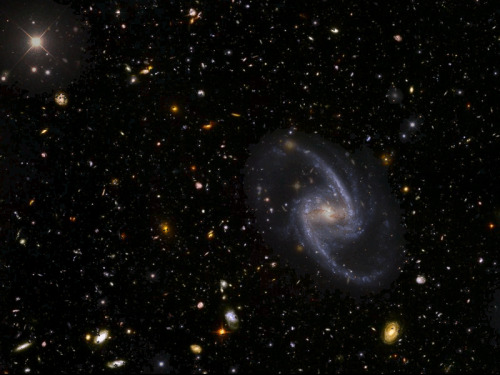Chris-z-2135-46-blog - Space Travel

More Posts from Chris-z-2135-46-blog and Others

First look at the system SpaceX plans to use to get to Mars
Elon Musk is sharing his vision for making humans a…

8 Things to Know About Our Commercial Crew Program
Two years after selecting the next generation of American spacecraft and rockets that will launch astronauts to the International Space Station, engineers and spaceflight specialists across our Commercial Crew Program, Boeing and SpaceX are putting in place the elements required for successful missions.

1. The Goal
The goal of our Commercial Crew Program is to return human spaceflight launches to U.S. soil, providing reliable and cost-effective access to low-Earth orbit on systems that meet our safety requirements. To accomplish this goal, we are taking a unique approach by asking private companies, Boeing and SpaceX, to develop human spaceflight systems to take over the task of flying astronauts to station.

2. Multi-User Spaceport
Boeing and SpaceX, like other commercial aerospace companies, are capitalizing on the unique experience and infrastructure along the Space Coast at our Kennedy Space Center and Cape Canaveral Air Force Station. Kennedy has transitioned from a government-only launch complex to a premier multi-user spaceport. In the coming years, the number of launch providers along the Space Coast is expected to more than double.

3. Innovation
Our expertise has been joined with industry innovations to produce the most advanced spacecraft to ever carry humans into orbit. Each company is developing its own unique systems to meet our safety requirements, and once certified by us, the providers will begin taking astronauts to the space station.

4. Research
With two new spacecraft that can carry up to four astronauts to the International Space Station with each of our missions, the number of resident crew will increase and will double the amount of time dedicated to research. That means new technologies and advances to improve life here on Earth and a better understanding of what it will take for long duration, deep space missions, including to Mars.

5. Crew Training
Astronauts Bob Behnken, Eric Boe, Doug Hurley and Suni Williams have been selected to train to fly flight tests aboard the Boeing CST-100 Starliner and SpaceX Crew Dragon.

The veteran crew have sent time in both spacecraft evaluating and training on their systems. Both providers are responsible for developing every aspect of the mission, from the spacesuits and training, to the rocket and spacecraft.

6. Launch Abort System
Boeing and SpaceX will equip their spacecraft with launch abort systems to get astronauts out of danger … FAST!

7. Expedited Delivery
Time-sensitive, critical experiments performed in orbit will be returned to Earth aboard commercial crew spacecraft, and returned to the scientists on Earth in hours, instead of days – before vital results are lost. That means better life and physical science research results, like VEGGIE, heart cells, and protein crystals.

8. Lifeboat
The spacecraft will offer safe and versatile lifeboats for the crew of the space station, whether an emergency on-orbit causes the crew to shelter for a brief time in safety, or leave the orbiting laboratory altogether. Learn more HERE.
Make sure to follow us on Tumblr for your regular dose of space: http://nasa.tumblr.com


Auroras on Jupiter
js


New view of the Pillars of Creation
js
How Will We Safely Send the First Humans to the Red Planet?
We’ve been exploring the Red Planet for over 50 years – Mariner 4 launched on this day (Nov. 28) in 1964 and took the first photos of Mars from space the following summer.

We first explored the surface 40 years ago (Viking, 1976) and have had a continuous scientific presence on Mars for nearly 20 years, starting with the landing of the Pathfinder lander and Sojourner rover on July 4, 1997.
We currently have three orbiters – MAVEN, MRO and Mars Odyssey – and two rovers – Curiosity and Opportunity – actively exploring Mars.
These robotic explorers have already taught us a lot about the Red Planet, and future missions will teach us even more about how humans can live and work on the surface.

After sending humans on space exploration missions for the last 50 years, we have gained the experience and knowledge to send the first people to Mars. We are working across all areas to prepare for that historic day and want to share our progress with you.
Building the ride to Mars: NASA’s Space Launch System.
Our ride to Mars, the Space Launch System, is being built right now to meet the challenges of exploring deep space. When it comes to our journey to Mars and beyond, there are no small steps. Our video series by the same name breaks down those steps to show how SLS will send missions to the Red Planet.

Living on the Space Station will help humans live safely on Mars.
New crew members of Expedition 50 will soon conduct more than 250 experiments on the International Space Station. More than 2,000 experiments have already been done!
Experiments in fields such as biology, Earth science, physical sciences and human research are helping us unlock the knowledge needed to enable humans to live in space for long durations. If you missed the recent launch, check out NASA TV for a replay.

Testing Orion helps crew live and work in space and get home safely.
Scheduled to launch atop the Space Launch System rocket for the first time in 2018, an uncrewed Orion will travel farther into space than any spacecraft built for humans has ever gone before. When Orion returns to Earth, splashing down into the Pacific Ocean, it will take a landing and recovery group to safely return the capsule and crew back to land. A variety of testing on the ground, including to structures and parachutes, is helping make sure Orion can safely carry crew to new destinations in the solar system.

In late October, this recovery group, including NASA’s Ground Systems Development and Operations Program, the U.S. Navy, U.S. Air Force and contractor employees, completed its fifth successful practice run to recover Orion aboard the USS San Diego.

We’re using high resolution imagery from the Mars Reconnaissance Orbiter to learn more about potential landing sites for a human mission.
Who knows what surprises the Red Planet holds?
Our Curiosity Rover has discovered all kinds of interesting Mars features including meteorites. How do you learn more about a meteorite? Zap it with lasers, of course.

This golf-ball-sized, iron-nickel meteorite was recently found on Mars where ancient lakebed environments once existed. Named “Egg Rock” for the area in which it was found, it is the first meteorite to be examined using a laser-firing spectrometer.
By studying the conditions on Mars with vehicles like Curiosity, scientists are able to help prepare future astronauts to live on Mars.
How do you prepare the tallest rocket ever built for its first launch?
Another important component in successfully launching the Space Launch System rocket and Orion spacecraft on a Journey to Mars is the infrastructure work being done by our Ground Systems Development and Operations Program at Kennedy Space Center.

While efforts at our Vehicle Assembly Building continue, we hope you’ll be making your plans to join us at the launch pad for the first flight of SLS with Orion in 2018!
Preparing for a human journey to Mars
The next Mars rover will launch in 2020, and will investigate a region of Mars where the ancient environment may have been favorable for microbial life, probing the Martian rocks for evidence of past life.

It will collect samples and cache them on the surface for potential return to Earth by a future mission. Mars 2020 will also conduct the first investigation into the usability and availability of Martian resources, including oxygen, in preparation for human missions.
Make sure to follow us on Tumblr for your regular dose of space: http://nasa.tumblr.com

Deep Magellanic Clouds Image Indicates Collisions : Did the two most famous satellite galaxies of our Milky Way Galaxy once collide? No one knows for sure, but a detailed inspection of deep images like that featured here give an indication that they have. Pictured, the Large Magellanic Cloud is on the bottom right. The surrounding field is monochrome color-inverted to highlight faint filaments, shown in gray. Perhaps surprisingly, the featured research-grade image was compiled with small telescopes to cover the large angular field nearly 40 degrees across. Much of the faint nebulosity is Galactic Cirrus clouds of thin dust in our own Galaxy, but a faint stream of stars does appear to be extending from the SMC toward the LMC. Also, stars surrounding the LMC appear asymmetrically distributed, indicating in simulations that they could well have been pulled off gravitationally in one or more collisions. Both the LMC and the SMC are visible to the unaided eye in southern skies. Future telescopic observations and computer simulations are sure to continue in a continuing effort to better understand the history of our Milky Way and its surroundings. via NASA
js


Trillions and Trillions
As far as astronomers know, this universe of ours is nearly 14 billion years old and 93 billion light-years across. Only objects between 10 to 12 billion light-years distant will ever be visible due to the expansion of the universe.
Recently, a new survey upped the believed galactic population from around 100 billion to TWO TRILLION.
Images: Left: NGC 1365 Credit: Jason Jennings Right: Hubble Deep Field added to the background of NGC 1365 Credit: NASA/ESA
-
 alaina2135-blog liked this · 8 years ago
alaina2135-blog liked this · 8 years ago -
 chris-z-2135-46-blog reblogged this · 8 years ago
chris-z-2135-46-blog reblogged this · 8 years ago